How to explore the benefits of your Complete Streets project
This tool can provide users with data to measure and demonstrate the benefits of a Complete Streets project in their own communities, from a site-level intervention such as the reconfiguration of an intersection, to a corridor-level intervention like installing bike lanes, shade trees, or widening pedestrian space.

Some data and skills are required
To use the tool in its entirety, some knowledge of data sources and GIS analysis is required, but it was designed to be accessible and generalizable for communities across the country, and draws from data sources that are generally easy to access and interpret.

Measuring the benefits across four areas of impact
This tool will guide you through a step-by-step process of gathering and entering data to produce the projected benefits across the impact categories of health, safety, environment, and economy—using an equity approach.

Economic
Safer Streets, Stronger Economies found that Complete Streets projects to support walking and biking not only reduced crashes and injuries but boosted employment levels, property values, investment from the private sector, and net new businesses.

Environment
When we make walking, biking, rolling, moving actively with an assistive device, and riding public transit safer, more convenient, and more accessible, people are more likely to choose these lower-emission options instead of driving alone.

Health
The health benefits of physical activity are incredibly important and broad-reaching. By designing our streets to support safe, activity-friendly routes for people walking, biking, rolling, and moving actively using assistive devices, we can provide more opportunities for physical activity as part of people’s daily routines.

Safety
To reverse the alarming trend of people struck and killed while walking we must protect all users of the transportation system through policies, programs, and funding. A Complete Street approach designs roads for all users, slows cars, and prevents crashes that can cause death or disability.

All four areas of impact are considered with an equity approach
To better understand who might benefit from your Complete Streets project, the tool compares data from your selected study area with the demographics of your project area or location. This information can inform your process of determining if the project supports your specific community’s equity efforts.